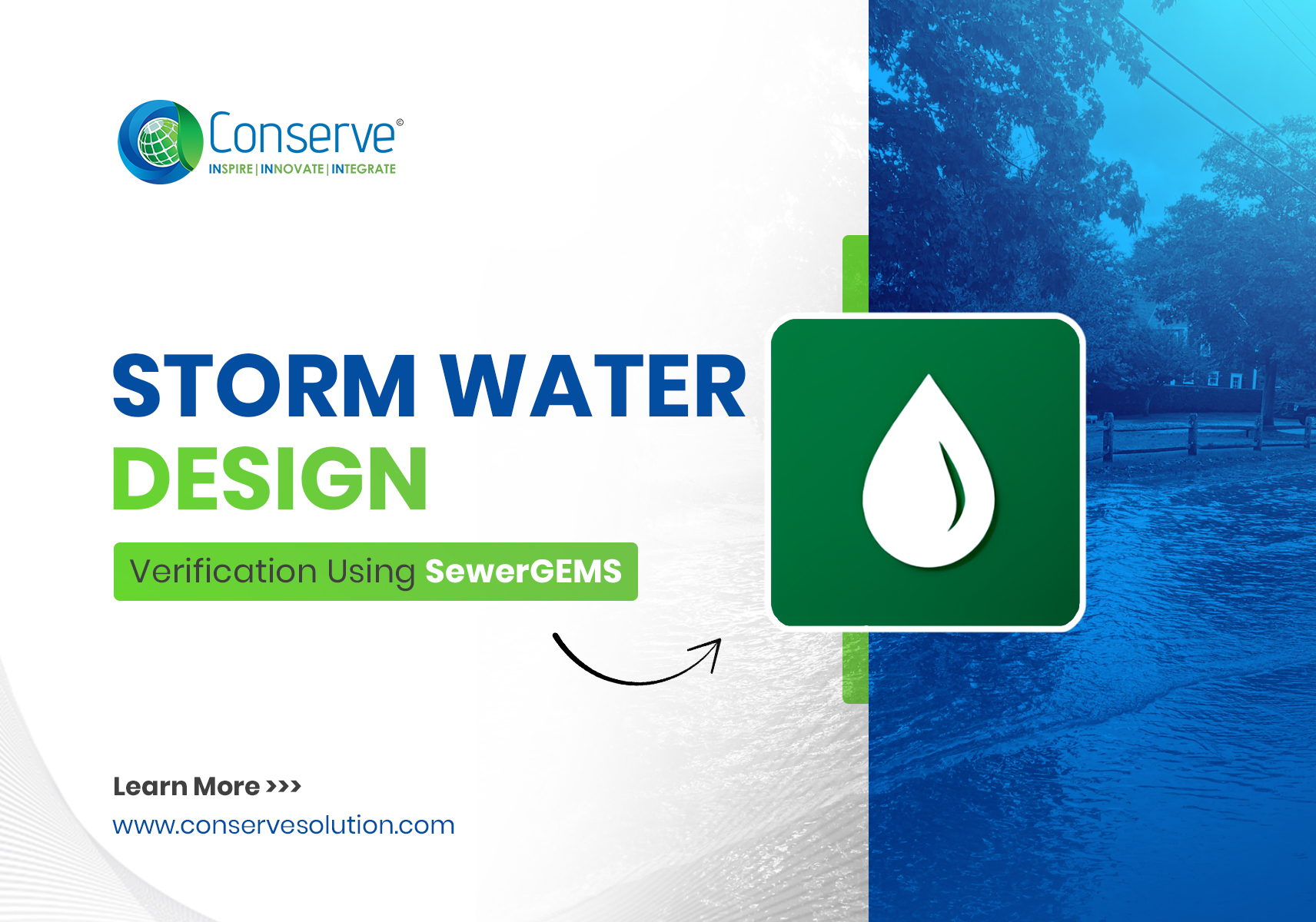As cities expand and climate change increases rainfall intensity, urban flooding has become a growing challenge. For infrastructure planners, the key lies in designing resilient stormwater drainage systems that can withstand both frequent and extreme events.
At Conserve Solutions, we approach stormwater management not just as an engineering task, but as a commitment to sustainable urban living. This case study highlights how our team used SewerGEMS with the Implicit (Dynamic Wave) Solver to verify stormwater design performance – ensuring safety, efficiency, and compliance in modern urban developments.
1. Overview of Stormwater Design Verification
Stormwater design verification is the process of validating whether a proposed drainage network can:
- Handle runoff from 10-year and 100-year storm events
- Maintain safe hydraulic levels without surcharging or overflow
- Optimize pipe network capacity while leaving buffer for future development
By integrating hydraulic and hydrologic modeling into the design workflow, we ensure drainage systems are both technically robust and future-ready.
2. Objectives of the Verification Process
The verification exercise focused on four key goals:
- Confirm peak runoff handling capacity during extreme storms
- Validate conduits, manholes, and outfalls against hydraulic criteria
- Identify bottlenecks and risks of flooding
Test the effectiveness of drainage elements like catch basins, pipe sizing, and slopes
3. Data Inputs for SewerGEMS Modelling
3.1 Catchment Characteristics
- Area – Surface contributing to runoff
- Runoff Coefficient (C) – Indicates land permeability & cover
- Time of Concentration (Tc) – Defines runoff travel time
Why it matters: These inputs determine how much and how fast water enters the system, directly influencing network sizing.
3.2 Rainfall Data
- IDF Curves (Intensity-Duration-Frequency) – For 10-year & 100-year storms
- Time-Depth Curves – To simulate accumulation and peak discharge

Why it matters: Accurate rainfall data = reliable flood modeling.
3.3 Pipe Network Details
- Material – RCC, PVC, HDPE
- Diameter & Slope – Control carrying capacity & flow direction
- Invert Levels – Ensure correct gravity flow

Why it matters: Small changes here can prevent costly overflows.
3.4 Topography
- Derived from GIS terrain models, contour maps, or survey data
- Defines catchment boundaries, rim levels, and flow paths
Why it matters: Elevations dictate whether water flows smoothly — or floods unexpectedly.
4. Hydraulic Modelling Approach
To ensure accuracy in simulating stormwater behavior, Conserve Solutions adopted a structured hydraulic modelling methodology within SewerGEMS.
- Solver – Implicit (Dynamic Wave):
This solver was selected for its ability to handle complex flow conditions, including backwater effects, surcharging, and dynamic interactions between network components. - Hydrologic Method – Unit Hydrograph:
The Unit Hydrograph approach was applied to transform rainfall data into runoff, providing realistic flow hydrographs for different storm scenarios. - Friction Loss – Hazen-Williams Equation:
Pipe headlosses were calculated using the Hazen-Williams formula, balancing hydraulic efficiency with practical pipe design considerations. - Outfall Condition – Free Outfall with Tailwater Defined:
Outfalls were modeled under free-flow conditions, with tailwater levels defined to ensure accurate downstream boundary conditions and prevent backflow into the network.
5. Design Constraints Applied
To ensure accuracy in simulating stormwater behavior, Conserve Solutions adopted a structured hydraulic modelling methodology within SewerGEMS.
- Pipe Flow Utilization – Max 75% of capacity (buffer for future growth)
- Minimum Velocity – 0.6 m/s for self-cleaning pipes
- Pipe Slope – ≥ 0.5% for small diameters
- Datum & Rim Levels – To keep Hydraulic Grade Line below ground
These constraints ensure long-term performance, low maintenance, and safety.
6. Verification Process
6.1 Model Setup in SewerGEMS
- Imported base layout from AutoCAD/GIS
- Defined network elements – pipes, manholes, catchments, outfalls
- Input design values – invert levels, diameters, elevations
6.2 Simulation of Storm Events
- Tested 10-year & 100-year return periods
- Checked flow paths, bottlenecks, surcharging, and capacity limits
7. Optimization & Refinement
Where bottlenecks were identified, our engineers adjusted:
- Pipe Resizing – To improve conveyance
- Slope Modifications – For better velocity
- Manhole Depths & Invert Levels – To balance flow
- Detention Structures – For peak runoff reduction
This iterative process ensured the network was both resilient and cost-efficient.
8. Deliverables for Clients
Using SewerGEMS, we provided:
- Pipe profile views – Visualizing depth and slope
- Color-coded maps – Showing velocity, HGL, utilization
- Flooding reports – Identifying at-risk nodes
- Summary tables & hydraulic reports – For submission & approvals
These insights allowed stakeholders to make informed design decisions early, saving time and reducing risks during construction.
 Conclusion
Conclusion
Stormwater management is no longer just about laying pipes — it’s about building climate-resilient cities. By applying SewerGEMS dynamic modeling, Conserve Solutions ensures that stormwater systems are future-proof, safe, and sustainable.
Our approach not only verifies compliance but also provides developers, consultants, and authorities with the confidence that their infrastructure can withstand tomorrow’s storms.
Looking to verify your stormwater design with precision?
Let’s collaborate to make your drainage systems efficient, compliant, and resilient.
Author
-

Mohamed Abdullah is a passionate BIM Professional specializing in BIM Project Execution and BIM Automation, with proven expertise in delivering high-quality digital solutions for the AEC industry. An Autodesk Certified Professional, He combines strong technical knowledge with extensive hands-on project experience to optimize workflows, improve efficiency, and enhance collaboration across multidisciplinary teams. With a blend of engineering expertise and software development skills, he develops and implements innovative BIM automation solutions that drive smarter project delivery.


